The Social Context of Folk Arts – Wedding Ceremonies
Traditional wedding is meant for the union of a male and a female, yin and title=”A large-scale “Happy baby” ball flower papercut yang, which lead to human propagation and perpetual life. The folk art works on custom wedding ceremony bear distinctive features on the theme. Fish, being a proliferous legendary animal, is often used to symbolize having multiple children. A yin-yang paired fish became a cultural code in Chinese folk art works.
At wedding ceremony, paper-cut “Fish playing around lotus,” “Fish biting lotus,” “Lotus bearing seeds” and “Happy dolls” (baby with coiled hair holding a pair of fish) are pasted on the ceiling of the bridal chamber. In northern Shaanxi, red or green paper-cutting of “Baby with coiled hair holding a pair of fish” in a big ball flower design is pasted on the center of the cave window. They are called “revolving flower,” as the revolving sky. The lower and middle part of the cave window is usually a lattice window in 36 counts. A large totem animal paper-cut (a tiger, a sheep or a deer) is over the middle four lattice; each corner lattice has a corner flower; the rest space are filled with colorful paper-cuts like “Buckled bowls,” “Paired fish,” “Fish playing around lotus,” “Lotus bearing babies,” “Rat eating pumpkins,” “Squirrel eating grape,” “Monkey eating peach,” “Rabbit eating cabbage,” “Golden pheasant visiting lotus flower” etc., making up a diamond square shaped “36 lattice window of clouds.” The colorful paper-cuttings against the white window paper liner definitely add a delightful atmosphere. In here, rat, squirrel, rabbit and golden pheasant are male; and lotus flower, pumpkin, grape, cabbage, peach are female. Putting animals and plants implies combining male and female for multiplication.
In the upper and middle reaches of the Yellow River, gift bread for wedding ceremony from the maternal family is a round bread made of two connecting fish, or a tiger head on a dragon body with a fish tail, with a world of living things plugged on the back. In Hua County, Shaanxi Province, the wedding bread is a “High rise bread platter” with a reed cylinder in the center as if connecting to the sky; and paired fish stuck on very layer from bottom up, such as a paired fish sharing one tiger head or a sheep head; a paired dragons with a tiger head; or a fish tail with a phoenix head. The top layer is a treasure bottle and a happy baby, a symbol of wealth and more children. At the wedding, two “High rise bread platters” are placed on each side of the table where the bride and the groom bow to the sky, to earth and to each other. It 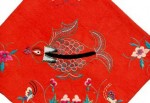 is quite a scene.
is quite a scene.
In Shaanxi, Shanxi and east of Gansu, a custom wedding embroidery is a hand made red undergarment, showing a fish (the bride) with an open cut on her body (a female uterus). It is part of the dowry as a gift from the bride to her groom. Other embroideries include male and female animals of proliferous nature; hanging ornaments of flowers and fruits; or a “Needle holder”, a “Needle toad”, as gifts for the female in-laws to show off bride’s craftsmanship. A custom in the monkey totem tribal culture in Henan is for the bride to embroider a male monkey, symbolic of her husband, and hide it at the bottom of the suitcase to take with her to the husband’s family on the wedding day. A secret porcelain “Happy baby,” with female coiled hair but a male body, is placed under the bed sheet on the wedding night. It is meant to be crushed during intercourse, a prayer for more children. Traditional porcelain “Happy baby” is still being made today at a porcelain cellar known for manufacturing the Song Dynasty porcelain in Yu county of Henan Province.
Shenyang Palace Museum
The Shenyang Palace Museum is located at thecenter of Jing-zi Dajie Center in Shenyang City, Liaoning Province. It covers 60,000 square meters and is a history museum with collections and exhibits that deal mainly with Qingdynasty art and artifacts. Formerly called the Fengtian Palace Museum, then the National Shenyang Museum, in 1954 it was officially renamed the Shenyang Palace Museum. In 1961, the State Council placed it among the ranks of National Key Cultural Relics Protected Units. The permanent exhibits of the museum are divided into two parts, one showing historical artifacts of the court and the other showing Qing-dynasty arts and crafts.
The Shenyang Palace Museum is the only well preserved group of ancient palace buildings in the country except for the Beijing Palace Museum. The complex is divided into three parts, the Eastern Way, the Central Way, and the Western Way. The architecture of the main building of the Eastern Way is characteristic of a horse riding arrow-shooting people who used tent palaces; this Dazheng Hall once hosted tremendous ceremonies.
The main building of the Central Way was where the emperor held daily meetings with his court to conduct governmental affairs and receive ministers. Inside, objects are arranged as they were during the Qianlong period. Inside a separate hall to the west are objects used by the emperors Qianlong and Jiaqing as these two emperors made their long investigative trips through the country.
On the western side of the Shenyang Palace Museum are riding grounds where horses were kept and trained, also a pavilion in which the emperor watched plays when he did his ‘eastern sojourn.’ There is also a reconstruction of a Ming-dynasty pavilion from Ningbo, which is one of the seven halls in the Qing dynasty to receive a copy of the famous Yongle-period encyclopedia known as the Siku Quanshu, or the Four Warehouses of All Knowledge.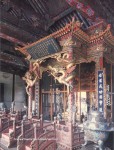
Most of the Shenyang Palace Museum collections of documents and artifacts date from the Qing dynasty, though some are from the Ming. Many are of interest for their historical value but some are of great artistic value as well, such as paintings by Dong Qichang (1555-1636), a famous Ming painter and calligrapher. Some of the more representative treasures that have been exhibited from the collections of the Museum are Qing-dynasty weapons, musical instruments, palace accouterments, ceramics, carvings, textiles and embroideries, lacquer ware, and amber.
Address: Liaoning Province, Shenyang City, Shenhe District, Shenyang Road, #171
Dragon Boat Festival
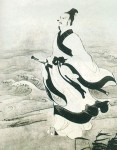 Double Fifth Festival, is celebrated on the fifth day of the fifth moon of the lunar calendar. It is one of the most important Chinese festivals.
Double Fifth Festival, is celebrated on the fifth day of the fifth moon of the lunar calendar. It is one of the most important Chinese festivals.Dragon Boat race: Traditions At the center of this festival are the dragon boat races. Competing teams drive their colorful dragon boats forward to the rhythm of beating drums. These exciting races were inspired by the villager’s valiant attempts to rescue Chu Yuan from the Mi Lo river. This tradition has remained unbroken for centuries.
Tzung Tzu (Pinyin: Zong-Zi): A very popular dish during the Dragon Boat festival is tzung tzu. This tasty dish consists of rice dumplings with meat, peanut, egg yolk, or other fillings wrapped in bamboo leaves. The tradition of tzung tzu is meant to remind us of the village fishermen scattering rice across the water of the Mi Low river in order to appease the river dragons so that they would not devour Chu Yuan.
Ay Taso (Pinyin: Ai-Cao): The time of year of the Dragon Boat Festival, the fifth lunar moon, has more significance than just the story of Chu Yuan. Many Chinese consider this time of year an especially dangerous time when extra efforts must be made to protect their family from illness. Families will hang various herbs, called Ay Tsao, on their door for protection. The drinking of realgar wine is thought to remove poisons from the body. Hsiang Bao are also worn. These sachets contain various fragrant medicinal herbs thought to protect the wearer from illness.
Zhouyuan Bronze Museum
Address: Shaanxi Province, Baoji City, Fugang County, Famen Town, Zhaochen Village
Zhaochen Village
Zhouyuan is an ancient region with more than 3,000 years of history. It is located in the western part of the Guanzhong Plain of Shaanxi Province and includes one of the capitals of the early period of the Zhou Dynasty. In history it is known as ‘Qi Zhou.’ The cultural relics both on and below ground are especially rich, and the large quantity of bronzes excavated here are world famous. In 1982, this was declared by the State Council to be a National Important Cultural Relics Protected Unit.
The Zhouyuan Museum (Chinese bronze artworks from Zhouyuan Bronze Museum) was built on the foundation of the excavation of the Zhouyuan site. It was formerly the site of two cultural relics Protection and Management Institutes called Zhouyuan Qishan and Fugang. In 1986 these were combined to become the Zhouyuan Museum which is located in Fugang County, Famen Town, Zhaochen Village. The Zhouyuan Museum’s existing exhibitions are divided into inside and outside components. The outside exhibitions are mainly the Village Ancestral Temple and the Zhaochen Village Palace, a large-scale architectural grouping. These provide a valuable resource for researching Western Zhou architecture and technology, and the political, economic and cultural systems of the court at that time. These fill what had been a void in ancient Chinese architectural history.
The inside exhibitions mainly include the Zhouyuan Excavated Relics Exhibit, the Zhouyuan Historical Cultural Relics Exhibit, Western Zhou Calligraphy and Arts Exhibit, Western Zhou Wine-Culture Exhibit, and the special exhibit at Famensi Temple which is called the Zhouyuan Precious Cultural Relics Special Exhibit. These exhibits display the some 3,000 items excavated at the Zhouyuan site, including bronzes, jades, bone, ceramics, augury tortoise shells, augury bones, and so on. In the exhibition, people c an enjoy bronzes from three thousand years ago such as one that has 284 characters inscribed on the boom of its interior, relating the history of six kings of Western Zhou and the important accomplishments of the currently-in-power seventh king. It also records the family history of the owner of the vessel, providing reliable data for researching Zhou-dynasty history. In the Western Zhou Wine-Culture Exhibition, around one hundred specimens of materials for fermenting alcohol, vessels for fermentation, articles for warming wine, for mixing alcohols and so on are exhibited. China’s earliest ceramic-material architectural tiles are also on display, which date to six to seven hundred years earlier than the Qin bricks and Han tiles of Chinese tradition. In the exhibit people can also see valuable western Zhou jiaguwen or oracle bone inscriptions, which record the relations between Zhou people and the Shang court as well as other countries. In the calligraphy section, examples of western Zhou calligraphy that have been excavated in recent years are on display.
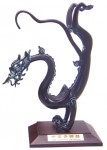 Dragon is a symbol of the Chinese nation. In history, the dragon of the Chinese nation as a common object of worship, God, art image, communicate a vast land of China from different nationalities, people of different faiths relations, the promotion of the nation’s mutual understanding and unity, the integration of different cultural unity has played a positive role. A long history and colorful culture of DRAGON, in traditional Chinese culture holds an extremely important position, are a symbol of Chinese traditional culture-Chinese bronze artworks.
Dragon is a symbol of the Chinese nation. In history, the dragon of the Chinese nation as a common object of worship, God, art image, communicate a vast land of China from different nationalities, people of different faiths relations, the promotion of the nation’s mutual understanding and unity, the integration of different cultural unity has played a positive role. A long history and colorful culture of DRAGON, in traditional Chinese culture holds an extremely important position, are a symbol of Chinese traditional culture-Chinese bronze artworks.
This bronze sculpture features a Chinese dragon standing on two front legs as if it were diving down in the air. In contrast to western counter part, the Chinese dragon is a snake-like creature has two horns and four claws. This bronze sculpture is an earlier version of the Chinese dragon which has a standout tail and no scales. The replica is well made, the dragon can balance itself with just two front claws on a flat surface.
This small and complex, graceful posture dragon, reflecting the ancient division of the production of master mechanics right, this is for the great collection. More information, please visit here.
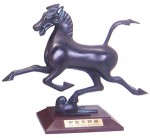 “The galloping horse with right hind foot on a swallow” is a famous cultural relic from the Eastern Han Dynasty (25 ~ 220). It is now the symbol of China tourism.
“The galloping horse with right hind foot on a swallow” is a famous cultural relic from the Eastern Han Dynasty (25 ~ 220). It is now the symbol of China tourism.
The neighing horse is galloping with its tail raised. Three of its hooves are in the air and its hind right hoof treads on a flying swallow which looks back in horror. Chinese ancient artisans combined realism and romanticism, and ingeniously integrated the galloping horse and flying swallow using rich imagination, original concepts and skillful craftsmanship. The romantic image of the swallow sets off the power and strength of the horse, instilling a rich, imaginative experience in viewers. Judging from the sculpture’s accurate balance, the gravity center must have been rigorously calculated. Mechanical analyses indicate that Bronze Galloping Horse finds a center of gravity in the swallow, which gives the statue its stability. Some experts also say this horse statue was used as a guide for finding the perfect steed.
 Qiang Pan (Qiang Plate) _ Chinese Bronze Vessel : Also known as Shi Qiang Pan (Shi Qiang Plate). Qiang is the first name of a person who is to the Western Zhou period, a historical officer of West Zhou.
Qiang Pan (Qiang Plate) _ Chinese Bronze Vessel : Also known as Shi Qiang Pan (Shi Qiang Plate). Qiang is the first name of a person who is to the Western Zhou period, a historical officer of West Zhou.